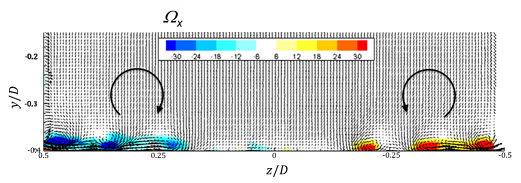The research conducted is the second phase of the same project conducted by John Vaccaro. It is an experimental investigation of flow control techniques in a compact inlet. This second phase has a new inlet duct geometry with a less aggressive 1.6 L/D ration and a new spline geometry that improved baseline pressure recovery and eliminated separation experienced on the upper surface of the previous work. In addition, a new flow control actuator was investigated in this research known as a fail-safe actuator that utilizes both passive and active elements (Figure 2).
The fail-safe actuator is composed of vortex generator vanes (VGs) and vortex generator jets (VGJs) to produce opposite sense vorticity to the natural secondary structures of the inlet. In a compact inlet, cross-stream pressure gradients are formed due to the high level of centerline curvature. These cross-stream pressure gradients result in migration of boundary layer fluid in the direction of the pressure gradient, which results in the secondary flows. In addition, the increase in cross-sectional area at the exit of the diffusing inlet leads to streamwise pressure gradients, which combine with the cross-stream pressure gradients resulting in distortion and total pressure loss at the exit.
A number of variables were tested on the fail-safe actuator including VG height, mass flow rate of the VGJs, as well as unsteady forcing with the VGJs at a number of frequencies. The effect of flow control was evaluated by pressure sensors at the aerodynamic interface plane (AIP) as well as along the bottom surface of the inlet. High frequency pressure transducers were also utilized at the AIP to observe the instantaneous pressure field at this location. In addition, PIV was conducted to observe the interaction of the VGJs and VGs and the effect of these devices on the inlet flow. The results of the fail-safe actuator showed improved pressure recovery as well as lower distortion levels from the baseline flow.

Figure 1: Compact Inlet

Figure 2: Fail-Safe Actuator

Figure 3: SPIV results at the beginning of the inlet for the Vortex Generator Jets case